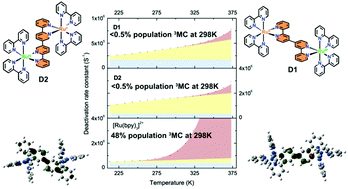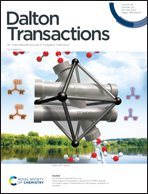Tuning the excited-state deactivation pathways of dinuclear ruthenium(ii) 2,2′-bipyridine complexes through bridging ligand design†
Abstract
A detailed photophysical investigation of two dinuclear ruthenium(II) complexes is reported. The two metallic centers were coordinated to a bis-2,2′-bipyridine bridging ligand, connected either through the para (Lp, Dp) or the meta position (Lm, Dm). The results obtained herein were compared to the prototypical [Ru(bpy)3]2+ parent compound. The formation of dinuclear complexes was accompanied by the expected increase in molar absorption coefficients, i.e. 12 000 M−1 cm−1, 17 000 M−1 cm−1, and 22 000 M−1 cm−1 at the lowest energy MLCTmax transition for [Ru(bpy)3]2+, Dm and Dp respectively. The Lp bridging ligand resulted in a ruthenium(II) dinuclear complex that absorbed more visible light, and had a longer-lived and more delocalized excited-state compared to a complex with the Lm bridging ligand. Variable temperature measurements provided valuable information about activation energies to the uppermost 3MLCT state and the metal-centered (3MC) state, often accompanied by irreversible ligand-loss chemistry. At 298 K, 48% of [Ru(bpy)3]2+* excited-state underwent deactivation through the 3MC state, whereas this deactivation pathway remained practically unpopulated (<0.5%) in both dinuclear complexes.



 Please wait while we load your content...
Please wait while we load your content...
